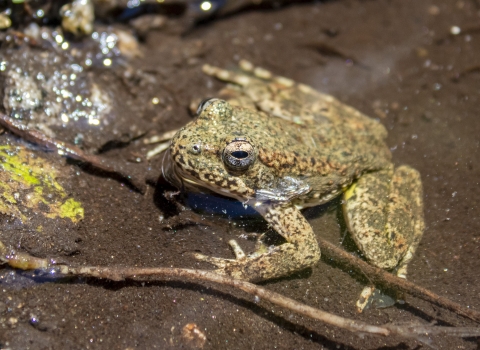Sacramento, Calif. - The U.S. Fish and Wildlife Service announced that it will provide Endangered Species Act protections to four of the six geographically and genetically distinct population segments (DPS) of the foothill yellow-legged frog.
After reviewing the best scientific and commercial information available, the Service determined endangered status for the South Sierra DPS and South Coast DPS and threatened status for the North Feather DPS and Central Coast DPS of the foothill yellow-legged frog. The Service is including a 4(d) rule for the North Feather DPS and Central Coast DPS that excepts take incidental to habitat restoration projects and forest fuels management activities that reduce the risk of catastrophic wildfire. The Service will designate critical habitat for the frog at a later date.
The foothill yellow-legged frog, named for its yellow belly and underside of its rear legs, is found from Oregon to southern California. While wide-ranging, the amphibian faces multiple threats, including altered waterflows related to water infrastructure, including dams and diversions; competition with and predation by non-native species such as bullfrogs and crayfish; disease; precipitation and temperature changes related to climate change climate change
Climate change includes both global warming driven by human-induced emissions of greenhouse gases and the resulting large-scale shifts in weather patterns. Though there have been previous periods of climatic change, since the mid-20th century humans have had an unprecedented impact on Earth's climate system and caused change on a global scale.
Learn more about climate change ; high-severity wildfires; water-related recreation; and habitat conversion and degradation.
“Our goal is to help the foothill yellow-legged frog recover across its range,” said Michael Fris, field supervisor of the Sacramento Fish and Wildlife Office. “The Endangered Species Act provides a critical safety net for fish, wildlife and plants and has prevented the extinction of hundreds of imperiled species.”
To assess the condition of each DPS, the Service evaluated data collected on the frog’s occupancy of streams in its historical range. The Service is listing the South Coast DPS and South Sierra DPS as endangered due to a strong pattern of declining stream occupancy, rapid reductions in occupied range and predicted inability to survive a catastrophic event. The North Feather DPS and Central Coast DPS will be listed as threatened due to decreasing levels of stream occupancy and the potential for a variety of threats to cause additional declines. The Service previously determined the North Coast DPS and North Sierra DPS are not warranted for listing after data showed high levels of occupancy in streams located throughout their ranges, giving them greater ability to withstand environmental changes and catastrophic events.
“Ongoing collaboration with a number of partners will result in positive conservation gains and put this frog on the road to recovery,” said Fris.
The Service worked closely with partners at the Oakland Zoo, U.S. Forest Service, Garcia and Associates, Pacific Gas and Electric Company and California Department of Fish and Wildlife to raise foothill yellow-legged frogs in captivity and release them into Plumas National Forest. To date, more than 250 frogs have been released into the forest as part of this effort.
A copy of the final decision will publish in the Federal Register on August 29, 2023, and is available in the Reading Room on August 28, 2023. The public can review the final listing and read supporting information at www.regulations.gov by searching Docket Number FWS–R8–ES–2021–0108. The effective date for the final rule will be Thursday, September 28, 2023.






